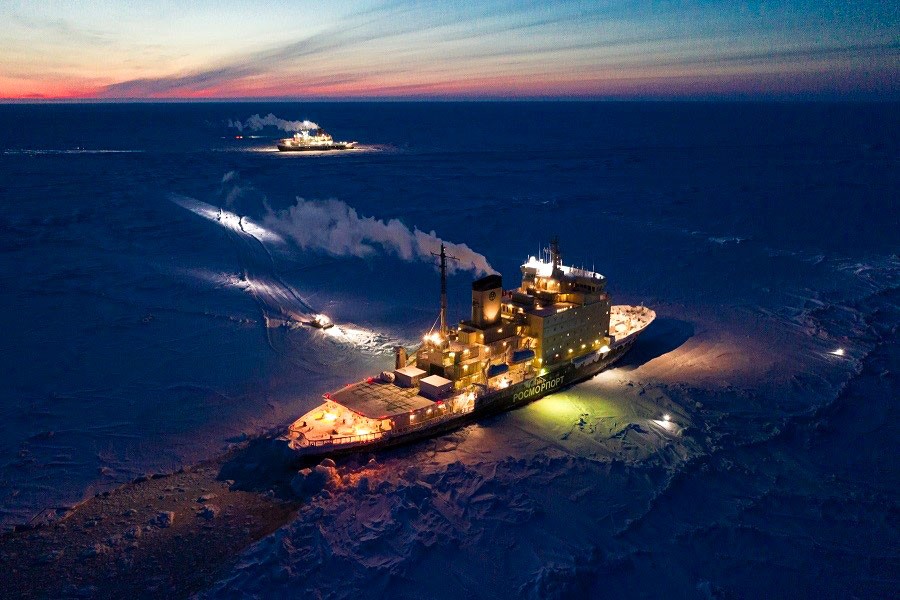Aid is on its way to an icebreaker struggling near the North Pole
The Kapitan Dranitsyn ran low on fuel after encountering conditions more difficult than expected during a resupply to the research ship Polarstern.

After reaching a record-setting point and completing a resupply rendezvous with the German research vessel Polarstern, the Russian icebreaker Kapitan Dranitsyn is in need of additional fuel after encountering more difficult than expected conditions.
On February 26, the 129-meter-long icebreaker set a world record, reaching the northernmost position ever by a diesel-engined vessel in winter.
Two days later, on February 28, it reached the German Arctic research vessel Polarstern, a long-awaited encounter for the members of Arctic expedition MOSAiC. On board the Russian ship were researchers and crew that are to replace personnel who have served in the Arctic ice since mid-December 2019.
The Kapitan Dranitsyn dropped anchor 970 meters from Polarstern, moored to the same floe and began a handover of personnel and 43 tons of goods.
The transfer took place at 88 degrees 28 minutes North, according to the Alfred Wegner Institute.
Help needed
But though the operation is part of the MOSAiC research expedition and had been carefully planned for many months, not everything went as planned.
The Russian icebreaker experienced extreme hardships on its way north. The ship set out from Tromsø, Norway, on February 3 and encountered highly difficult conditions as it later made it through the ice.
Ice thickness in parts of the area is as much as 160 centimeters and several places pack ice hummocks have grown several meters tall.
Repeatedly, the ship had to wait for improved weather and ice conditions, change course and circumvent extremely icy parts. On some of the days, the icebreaker managed to sail only 20 miles per day, a distance it normally manages to break through in a couple of hours, according to the ship’s owner, Rosmorport.
During the difficult voyage, the Kapitan Dranitsyn consumed far more fuel than planned and now needs assistance to make it back to the Russian mainland.
According to the Alfred Wegner Institute, the icebreaker Admiral Makarov is to come to the assistance of the Kapitan Dranitsyn. The former will bring the extra fuel needed.
Return to Tromsø
The Kapitan Dranitsyn left the Polarstern on March 4 and set course for Tromsø. On board are not only returning researchers and crew members but also collected research materials that now are to undergo additional analysis.
As of March 4, the Admiral Makarov was still moored in Murmansk, ship tracking data indicate.
It is not the first time that the Kapitan Dranitsyn has experienced ice conditions beyond the limits of its capacities. In the winter of 2018, the icebreaker got ice-locked for several months as it delivered goods to the east Arctic town of Pevek.
Biggest Arctic expedition
On board the Polarstern are more than 120 people, including several teams of researchers that have been preparing for the voyage for several years. It is the most comprehensive Arctic expedition ever, with a total budget of more than €140 million.
The ship, a German-built icebreaker operated by the Alfred Wegener Institute for Polar and Marine Research (AWI), in early October 2019 sailed deep into the ice and has subsequently drifted with the ice.
Over the course of the expedition, up to 600 experts will be on board the vessel, and be exchanged in phases. In addition, around 300 people will work in the background to make the expedition possible.
Representatives of 19 countries take part in the MOSAiC.
Ice air strip
Four icebreakers from Russia, Sweden and China are planned to assist the Polarstern in the course of the year. Among them will the new Chinese icebreaker Xue Long 2. In spring 2020, a landing strip will be built on the Arctic ice, to serve the German research aircraft Polar 5 and Polar 6.
On board the Polarstern are snowcats that have have recently prepared a 900-meter-long landing strip that is planned to be used for aircraft. The next shift of crew and personnel is likely to be done by aircraft, the expedition members say.
The MOSAiC will contribute to a quantum leap in our understanding of the coupled Arctic climate system and its representation in global climate models, lead scientist Markus Rex said in a presentation in May 2019.
It is now Torsten Kanzow from the Alfred Wegener Institute that is in charge as chief scientist on board. Kanzow arrived at the site last week by helicopter.